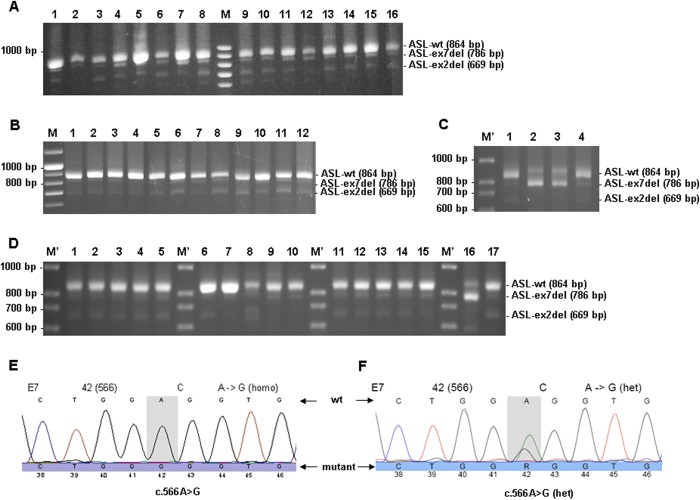FIGURE 2.
Occurrence of transcript variants of the ASL gene in different tissues. PCR products representing short fragments of ASL cDNA from 16 different tissues (A), from cultured skin fibroblasts derived from 12 ASA patients (B), from lymphocytes derived from two ASA patients and one patient's mother (C), and from controls' lymphocytes, livers, and fibroblasts as well as lymphocytes derived from one ASA patient and his mother (D). A, lane 1, skin fibroblast; lane 2, brain; lane 3, placenta; lane 4, lung; lane 5, liver; lane 6, skeletal muscle; lane 7, kidney; lane 8, pancreas; lane 9, spleen; lane 10, thymus; lane 11, prostate; lane 12, testis; lane 13, ovary; lane 14, small intestine; lane 15, colon; lane 16, peripheral leukocytes. B, lanes 1–12 (obtained from three different investigations), skin fibroblasts from 12 ASA patients with 10 different genotypes. C, lane 1, mother of patient in lane 2; lanes 2 and 3, two ASA patients; lane 4, control. D, lanes 1–15, five controls' lymphocytes (lanes 1–5), livers (lane 6–10), and fibroblasts (lanes 11–15); lane 16, lymphocytes from one patient (same patient as in Fig. 2C, lane 2); lane 17, lymphocytes from mother of patient in lane 16 (same as in Fig. 2C, lane 1). E, sequencing chromatogram of PCR product from lane 2 in Fig. 2C. F, sequencing chromatogram of PCR product from lane 3 in C. M, peqGOLD 100-bp DNA ladder plus (Peqlab, Erlangen, Germany); M′, 100-bp DNA ladder (Solis BioDyne, Tartu, Estonia). Gel electrophoresis was done in 1% agarose.

